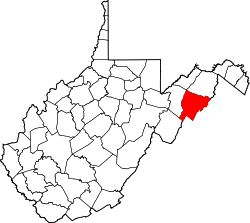Tannery, West Virginia | |
|---|---|
| Coordinates: 39°3′5″N78°57′26″W / 39.05139°N 78.95722°W | |
| Country | United States |
| State | West Virginia |
| County | Hardy |
| Elevation | 892 ft (272 m) |
| Time zone | UTC-5 (Eastern (EST)) |
| • Summer (DST) | UTC-4 (EDT) |
| GNIS feature ID | 1555780 [1] |
Tannery is an unincorporated community in Hardy County, West Virginia, United States. Tannery is located south of Moorefield on the South Fork South Branch Potomac River.


